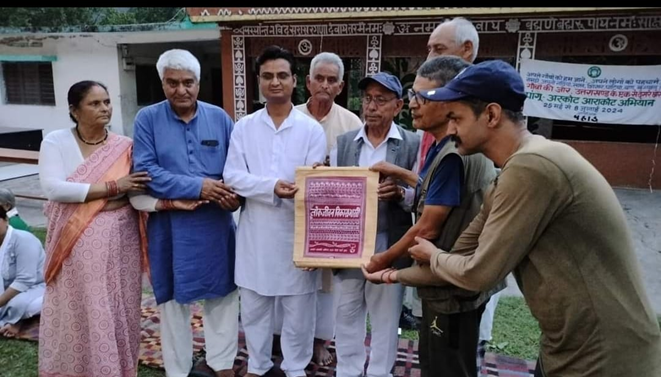The 6th ‘Askot to Aarkot’ expedition has concluded on 08 July at Aarkot, Uttarkashi adjoining Himanchal Pradesh. The expedition motivated by Late Sundarlal Bahuguna was started in 1974 on 25 May coinciding with birth anniversary of the great freedom fighter Shridev Suman who died in Tehri prison in 1944 after being on ‘hunger strike’ for 84 days.
Since 1974 this Yatra has been repeated
after every 10 years and this was the 6th edition and the golden
jubilee year . The Yatra conducted by various groups on various routes
in order to cover maximum villages and ground ,under the banner of 'Pahad' an NGO and being led by Dr Shekhar Pathak . The purpose was to know the
hills and its people . to have a two way communication with them. To assess
progress made during the period.
Numerous stories of interaction with the
villagers emerged and related by the group members. One such story is very
interesting and moving. It is from ‘Budha Kedar’ a village in the district
Tehri Garhwal of Uttarakhand , the place is famous for its Shiv Temple which
has the biggest ‘Shiv Linga’ in north India so it is believed. It is also a
trekking area . When a group of ‘Askot-Aarkot’
expedition reached this village they
were welcomed by them and they knew of their expedition as the village had
hosted previous members . During the conversation they learnt that three
friends belonging to three different castes chose to stay together under one
roof and share the common kitchen for 12 years . What is noteworthy was that in
villages caste consideration and caste hierarchy are well defined and practiced
still . But these three friends had developed a bond during their schooling
together and were also part of the ‘Sarvodaya’
movement which had reached this
remote village in late forties after Independence.
In 1950 when the Nation was celebrating its first
Republic day three friends- Dharmanand Nautiyal
a Brahmin , Bahadur Singh Rana a Kshatriya and Bharpura Nagwan a
Shilpkar moved together in one house
with family and children . The house still stands there as proof of their
unique experiment and symbolism. They stayed together and earned their
livelihood together . Many people opposed their move but they withstood their
ground ,some were appreciative but in subdued voices. The social awareness
imbibed by the three in ‘Gram Swaraj’ movement of Sarvodaya had made the
friends ideologically strong. For their livelihood Nautiyal had his shop in the
village , Rana had his land to till and Nagwan was employed in village for
various masonry work.
This bold step was taken after an initial
experiment. Nautiyal had his shop in which as per practice and tradition he
kept three ‘Hukkas’ for the three different castes . He removed two and just
kept one and observed the response . The favourable response motivated the friends to take the revolutionary step. They
together built a three storey house . They would also organise combined feasts
for all castes together , the home had become a symbol of progress and
development, not only social but economic development . When they parted
amicably as friends they remained friends .
The group visited the house where the friends
had stayed and son of Nautiyal Shri Dhirendra Prasad Nautiyal was present. This
is an inspiring story in such times when class , community and caste
considerations are even sharper. The Nation wide caste census is the demand of
many political parties.
This story appeared in ‘Avikal Uttarakhand’ a
digital platform and was written by Arun Kuksal.
I felt so proud of
my State after reading this story
because I know that in any other village in India this was not possible
and even if the friends had attempted they would have been thrown out
of the village.
Perhaps this was a dream of Mahatma Gandhi when he talked and wrote of 'Village Republic'.




कोई टिप्पणी नहीं:
एक टिप्पणी भेजें